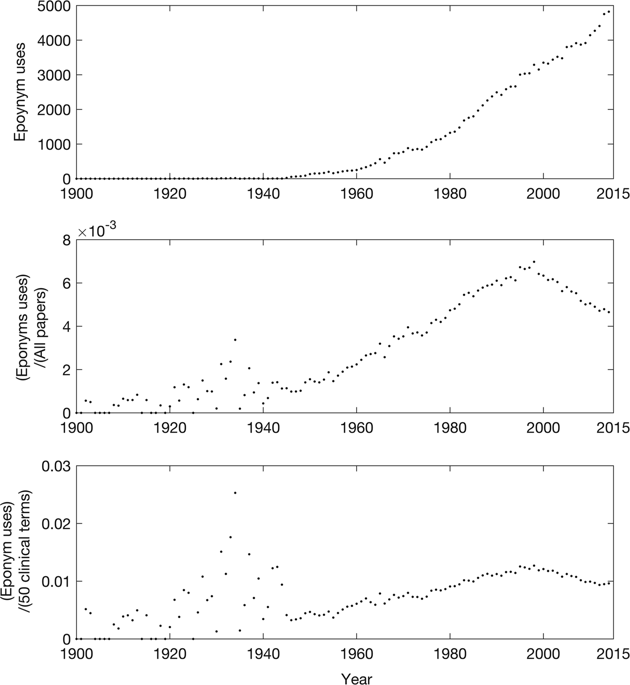Our official English website, www.x-mol.net, welcomes your
feedback! (Note: you will need to create a separate account there.)
Comment on: Eponymous women in ophthalmology: syndromes with prominent eye manifestations named after female physicians
Eye ( IF 2.8 ) Pub Date : 2018-12-14 , DOI: 10.1038/s41433-018-0313-y Peter B M Thomas 1 , Chrishan D Gunasekera 2
Eye ( IF 2.8 ) Pub Date : 2018-12-14 , DOI: 10.1038/s41433-018-0313-y Peter B M Thomas 1 , Chrishan D Gunasekera 2
Affiliation

|
Correspondence: We read with interest Van Tassel et al.’s “Eponymous women in ophthalmology: syndromes with prominent eye manifestations named after female physicians” [1]. The study of medical eponyms unearths many interesting stories: some are interesting trivia (did Adolf von Baeyer really name barbiturates for a Bavarian barmaid called Barbara? [2]), others are profoundly upsetting (Hans Eppinger’s investigation of concentration camp prisoners’ life expectancy with only salt water to drink [3]). The description of gender imbalance among medical eponyms is certainly a worthy addition to the field. In their opening paragraph Van Tassel et al. repeat the common assertion that there has been a “decline in eponym use”. In 2016, we described the rise and fall of 8636 extant and extinct medical eponyms in PubMed’s database of around 25 million articles spanning two centuries [4]. In Fig. 1 we present a new subset analysis of the use of 291 ophthalmic eponyms. The findings are consistent with those of the broader dataset. Eponyms are today used in the titles of more PubMed indexed entries than at any time in the past, and the annual growth remains rapid. Accounting for the inexorably increasing number of publications per year, we find a modest decrease in the prevalence of eponyms since their peak in the 1990s (to the levels seen around 1980). We find evidence to suggest that this decreasing prevalence can in part be accounted for by an increasing non-clinical presence on PubMed (by comparing eponym use to clinical words like “artery”). There was also evidence in our original study [4] (by comparison to a historical index of eponyms), that studies like ours are likely to underestimate eponym coinage—newly coined eponyms are not yet present in lists of common medical eponyms. Interestingly, we also found that coinage of well-established eponyms was brisk at the time that articles mourning their loss were originally being written [5]. In summary, there is no convincing evidence that medical or ophthalmic eponyms are in precipitous decline. Perpetuating the idea that they are could become self-fulfilling, discouraging new eponym coinage. This will do nothing to create a more even gender balance among medical eponyms.
中文翻译:

评论:眼科同名女性:以女医生命名的具有突出眼部表现的综合征
通信:我们饶有兴趣地阅读了 Van Tassel 等人的“眼科同名女性:以女医生命名的具有突出眼部表现的综合征”[1]。医学同名研究发现了许多有趣的故事:有些是有趣的琐事(阿道夫·冯·拜耶真的为一位名叫芭芭拉的巴伐利亚酒吧女招待命名巴比妥类药物吗?[2]),其他则令人深感不安(汉斯·埃平格对集中营囚犯预期寿命的调查与只能喝盐水[3])。医学同名之间性别失衡的描述无疑是该领域的一个有价值的补充。在他们的开篇段落中,Van Tassel 等人。重复“同名使用下降”的普遍说法。2016 年,我们描述了 PubMed 数据库中 8636 个现存和灭绝的医学名称的兴衰,该数据库包含跨越两个世纪的约 2500 万篇文章[4]。在图 1 中,我们展示了使用 291 个眼科名称的新子集分析。研究结果与更广泛的数据集的结果一致。今天,在 PubMed 索引条目的标题中使用的同名比以往任何时候都多,而且每年的增长仍然很快。考虑到每年的出版物数量不可阻挡地增加,我们发现自 1990 年代达到顶峰以来,同名的流行率略有下降(到 1980 年左右的水平)。我们发现证据表明,这种流行率下降的部分原因是 PubMed 上非临床存在的增加(通过将同名使用与“动脉”等临床词进行比较)。我们最初的研究 [4] 中也有证据(与同名的历史索引相比),像我们这样的研究可能低估了同名造词——新造的同名尚未出现在常见的医学同名列表中。有趣的是,我们还发现,在最初撰写哀悼其逝去的文章时,已经建立的同名的造币活动很活跃 [5]。总之,没有令人信服的证据表明医学或眼科的同名词正在急剧下降。延续他们的想法可能会自我实现,阻止新的同名造币。这无助于在医学同名之间创造更均匀的性别平衡。像我们这样的研究可能会低估同名造词——新造的同名尚未出现在常见的医学同名名单中。有趣的是,我们还发现,在最初撰写哀悼其逝去的文章时,已经建立的同名的造币活动很活跃 [5]。总之,没有令人信服的证据表明医学或眼科的同名词正在急剧下降。延续他们的想法可能会自我实现,阻止新的同名造币。这无助于在医学同名之间创造更均匀的性别平衡。像我们这样的研究可能会低估同名造词——新造的同名尚未出现在常见的医学同名名单中。有趣的是,我们还发现,在最初撰写哀悼其逝去的文章时,已经建立的同名的造币活动很活跃 [5]。总之,没有令人信服的证据表明医学或眼科的同名词正在急剧下降。延续他们的想法可能会自我实现,阻止新的同名造币。这无助于在医学同名之间创造更均匀的性别平衡。没有令人信服的证据表明医学或眼科地名正在急剧减少。延续他们的想法可能会自我实现,阻止新的同名造币。这无助于在医学同名之间创造更均匀的性别平衡。没有令人信服的证据表明医学或眼科地名正在急剧减少。延续他们的想法可能会自我实现,阻止新的同名造币。这无助于在医学同名之间创造更均匀的性别平衡。
更新日期:2018-12-14
中文翻译:

评论:眼科同名女性:以女医生命名的具有突出眼部表现的综合征
通信:我们饶有兴趣地阅读了 Van Tassel 等人的“眼科同名女性:以女医生命名的具有突出眼部表现的综合征”[1]。医学同名研究发现了许多有趣的故事:有些是有趣的琐事(阿道夫·冯·拜耶真的为一位名叫芭芭拉的巴伐利亚酒吧女招待命名巴比妥类药物吗?[2]),其他则令人深感不安(汉斯·埃平格对集中营囚犯预期寿命的调查与只能喝盐水[3])。医学同名之间性别失衡的描述无疑是该领域的一个有价值的补充。在他们的开篇段落中,Van Tassel 等人。重复“同名使用下降”的普遍说法。2016 年,我们描述了 PubMed 数据库中 8636 个现存和灭绝的医学名称的兴衰,该数据库包含跨越两个世纪的约 2500 万篇文章[4]。在图 1 中,我们展示了使用 291 个眼科名称的新子集分析。研究结果与更广泛的数据集的结果一致。今天,在 PubMed 索引条目的标题中使用的同名比以往任何时候都多,而且每年的增长仍然很快。考虑到每年的出版物数量不可阻挡地增加,我们发现自 1990 年代达到顶峰以来,同名的流行率略有下降(到 1980 年左右的水平)。我们发现证据表明,这种流行率下降的部分原因是 PubMed 上非临床存在的增加(通过将同名使用与“动脉”等临床词进行比较)。我们最初的研究 [4] 中也有证据(与同名的历史索引相比),像我们这样的研究可能低估了同名造词——新造的同名尚未出现在常见的医学同名列表中。有趣的是,我们还发现,在最初撰写哀悼其逝去的文章时,已经建立的同名的造币活动很活跃 [5]。总之,没有令人信服的证据表明医学或眼科的同名词正在急剧下降。延续他们的想法可能会自我实现,阻止新的同名造币。这无助于在医学同名之间创造更均匀的性别平衡。像我们这样的研究可能会低估同名造词——新造的同名尚未出现在常见的医学同名名单中。有趣的是,我们还发现,在最初撰写哀悼其逝去的文章时,已经建立的同名的造币活动很活跃 [5]。总之,没有令人信服的证据表明医学或眼科的同名词正在急剧下降。延续他们的想法可能会自我实现,阻止新的同名造币。这无助于在医学同名之间创造更均匀的性别平衡。像我们这样的研究可能会低估同名造词——新造的同名尚未出现在常见的医学同名名单中。有趣的是,我们还发现,在最初撰写哀悼其逝去的文章时,已经建立的同名的造币活动很活跃 [5]。总之,没有令人信服的证据表明医学或眼科的同名词正在急剧下降。延续他们的想法可能会自我实现,阻止新的同名造币。这无助于在医学同名之间创造更均匀的性别平衡。没有令人信服的证据表明医学或眼科地名正在急剧减少。延续他们的想法可能会自我实现,阻止新的同名造币。这无助于在医学同名之间创造更均匀的性别平衡。没有令人信服的证据表明医学或眼科地名正在急剧减少。延续他们的想法可能会自我实现,阻止新的同名造币。这无助于在医学同名之间创造更均匀的性别平衡。





















































 京公网安备 11010802027423号
京公网安备 11010802027423号